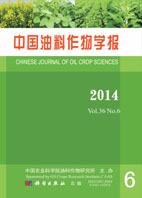LI Jun, LIU Li-xin, ZHANG Chun-le, GUAN Chun-yun*, DAI Lu-lu, ZHANG Li-yan, TAN Tai-long, MA Ni, YUN Jin-zhan
To understand the mechanism of NaHSO3 as a photosynthetic accelerator on rapeseed, the effects of NaHSO3 on growth, nitrogen metabolism and photosynthetic characteristics of Brassica napus cultivar Zhuangshuang 11 were investigated in liquid solution added with NaHSO3 at the concentration of 0-0.08 mmol/L. Results showed that with 0.02 mmol/L NaHSO3, plant height increased by 21.0%, 28.4% and 40.4% respectively after 10, 15 and 20 days. Their fresh weight and root length were also increased but not significantly different to the control. With 0.08 mmol/L NaHSO3, root length was significantly decreased by 15.1-16.5% after 10-15 days. Contents of chlorophyll b and total chlorophyll in rapeseed seedlings significantly increased for all concentrations of NaHSO3 treatment. Increase of chlorophyll a was observed only at 0.02 mmol/L NaHSO3 treatment, and the highest contents of chlorophyll b and total chlorophyll were achieved at this treatment. After NaHSO3 treatment, photosynthetic rate (Pn), light saturation point (LCP) and apparent quantum efficiency (AQY) increased significantly, while respiration rate (Rp), intercellular concentration of CO2 (Ci) and transpiration rate (Tr) declined significantly. With a higher maximum light energy conversion rate (Fv/Fm) and actual light energy conversion rate (ΦPSⅡ) and a lower non-photochemical quenching coefficient (NPQ), the low concentration of NaHSO3 resulted in an increasing of the share of light energy which was used to describing photochemical transfer. The activity of nitrate reductase (NR) and glutamine synthetase (SR) increased after NaHSO3 treatment. In conclusion, NaHSO3 improved the photosynthesis through the increase of content of chlorophyll b, which led to a higher efficiency of electronic absorption and transportation.
